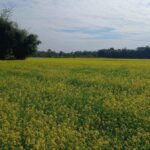A few years ago, Pabitra Bhuin, a 50-year-old tribal farmer of Sundargarh district in Odisha, found it very difficult to sustain his six-member family with his two acres of land.
“I used to grow vegetables and corn along with rice paddy. Here in the tribal areas there’s no irrigation facility. Also, paddy often gets destroyed because of unseasonal rain induced by climate change,” said Bhuin. “I couldn’t grow any profitable vegetables or corn.”
Millet cultivation in tribal Odisha
But his situation changed after he started cultivating millets in 2019 in one acre of his land. The district administration provided seeds, technical support and farm tools to help him grow the small-seeded grain.
“Today I prefer cultivating millets over other crops. Millets need less labour and water, but the harvest is more,” he said.
Millet cultivation has improved the lives of hundreds of tribal farmers like Pabitra Bhuin in the Sundargarh district.
Government launches the Odisha Millet Mission
Launching its flagship programme, the Odisha Millets Mission (OMM), in 2017 Odisha’s Department of Agriculture and Farmers’ Empowerment has been promoting the cultivation of millets in the state to boost the livelihood of farmers in hilly and tribal regions.

The state was recently recognised as the “Best Millets Promoting State” and received the Poshak Anaj Awards from the central government.
With millets being cultivated in 11 out of 17 administrative blocks, Sundargarh is the top millet producing districts in the state. Both finger millet – popularly known as ragi – and little millet are promoted under OMM, Sundargarh farmers prefer growing ragi.
The program covers all aspects of millet ecosystem that includes production, consumption, processing, marketing and inclusion of millets in state nutrition programmes.
Presently more than 16,000 farmers cultivate millets in 5,230 hectares of land. In the 2020-21 financial year, 5,093 farmers grew millets in 2,336 hectares.
What are the nutritional benefits of millets?
Being locally available and rich in nutrients, eating millets is beneficial to children’s health.
It is no wonder that the district administration has included millets in the special nutrition programme for children under the Integrated Child Development Services (ICDS) scheme of the state’s Women & Child Development Department.
Under Mission Shakti – a programme to empower millions of women through various economic activities – women self-help groups (SHGs) prepare ragi laddu mix with powdered millets, sugar and peanuts for the government-run anganwadi (child care) centres.

During the pandemic, when the centres were closed, anganwadi workers went on a door-to-door drive to distribute the ragi mix.
As the nutrition programme completes one year, over 60,000 children aged between 3 and 6 years in Sundargarh benefit from this initiative.
Millets are also being supplied through the public distribution system to ration card and food security card holders.
For this the government purchased 709 tonnes of ragi cultivated in Sundargarh at a minimum support price of Rs 329.5/tonne.
How millets are empowering tribal Odiya women
Under Mission Shakti the state government has been training SHG members to prepare snacks and food items with millets and to manage kiosks and cafes to offer millet-based foods.
To make millet-based food popular and provide livelihood opportunities to these SHG women, the district administration plans to set up 81 “Millets Shakti” kiosks in different places. The first kiosk was recently opened to a wide reception at Rajgangpur block.
The District Mineral Foundation in Sundargarh is providing financial support for millet cultivation in seven of the 11 blocks, helping with technical support and input to farmers too.
“We’re taking all measures to ensure that millet farmers get the right price for their produce,” said Rama Chandra Nayak, chief district agriculture officer and project director, Agricultural Technology Management Agency – the district level agency of the agriculture department.
“Various programmes are organised to popularise the consumption of millet-based food items,” he added.
What are the other significant benefits of millet cultivation?
“With high lands, Sundargarh suits millet cropping pattern. A sizable number of women farmers are a part of this growth story,” said Nikhil Pavan Kalyan, the district collector-cum-magistrate.

“Millet cultivation serve three purposes – it adds to the livelihood of farmers, the income of SHG women and ensures the nutrition of children,” he added.
In 2018, following India’s recommendation, Food and Agriculture Organisation announced that 2023 would be the “International Year of Millets”, with the United Nations endorsing it in April 2021.
The idea is to bring back these nutri-cereals, ensuring food and nutrition security, while enabling climate-resilience to farmers.
“Last year I cultivated millets in four acres and made reasonable money,” said Mary Manjula Hembram, a woman farmer.
Because of its climate resilience and reduced water use ragi cultivation gives increased income for farmers such as Hembram, and boosts the nutrition level of the tribes of Sundargarh.
Sarada Lahangir is a Bhubaneswar-based journalist, who writes about development, conflict, gender, health and education.








